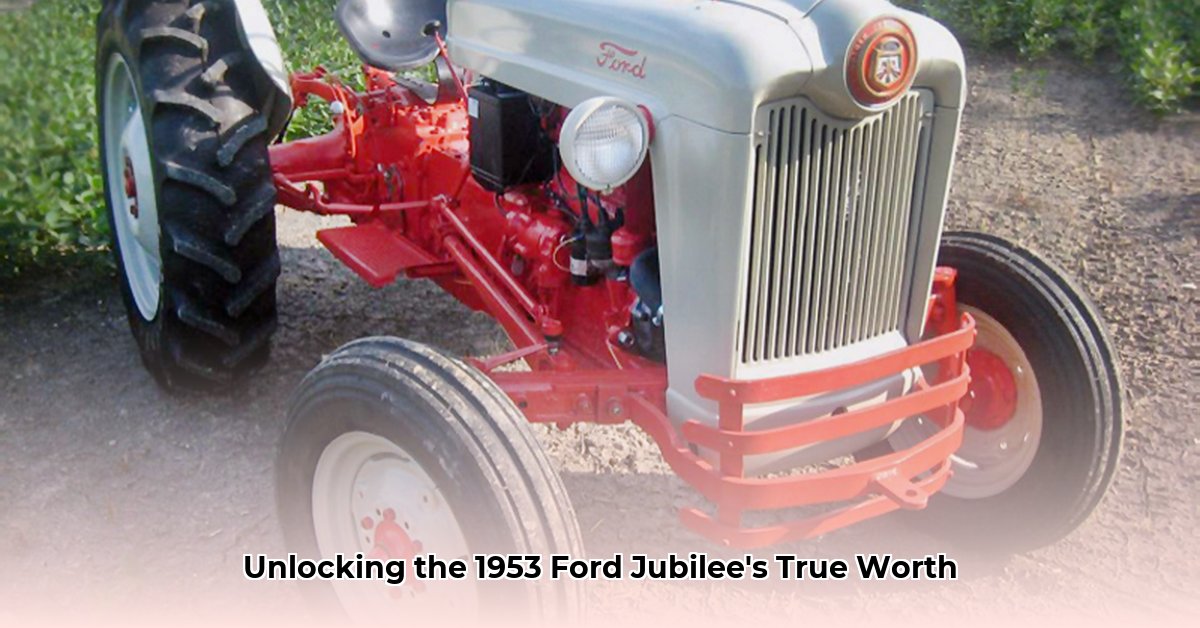
Considering the purchase or sale of a 1953 Ford Jubilee tractor? Understanding its true value requires a nuanced approach, encompassing a range of factors beyond simple age. This comprehensive guide provides a detailed market analysis, actionable advice for buyers and sellers, and a clear understanding of the elements that influence the price of this classic piece of farm equipment. For more information on Ford tractor weights, check out this helpful resource: [Ford Tractor Weights](https://ford-3000-tractor-weight.pages.dev).
Factors Affecting Value: A Detailed Breakdown
Several key factors combine to determine the value of a 1953 Ford Jubilee. Each element contributes to the overall picture, much like ingredients in a recipe.
Condition: The Cornerstone of Value
The condition of the tractor is paramount. A fully restored Jubilee in pristine condition commands a significantly higher price than one in poor repair. This includes both the visual state (paint, rust, dents) and mechanical functionality (engine performance, transmission smoothness, hydraulics). A tractor that runs smoothly and efficiently is far more valuable than an aesthetically pleasing but mechanically unsound machine.
Originality: Untouched is Often Best
Collectors highly prize originality. Tractors retaining their original paint, parts, and features command a premium. A well-documented history, including maintenance records and previous owners, further enhances value. These details increase authenticity and collector appeal.
Rarity: Unique Features and Configurations
While the 1953 Ford Jubilee wasn't a limited production model, variations in features or accessories can impact value. Unique configurations or rare attachments can significantly increase desirability among collectors. Researching your specific tractor's features is crucial in determining its worth.
Parts Availability: A Practical Consideration
The availability and cost of replacement parts are critical factors, particularly for older equipment. A tractor requiring extensive repairs will be less attractive (and less valuable) due to the potential costs and time investment required for restoration.
Market Analysis: Price Range and Current Trends
The price range for a 1953 Ford Jubilee is substantial, reflecting the wide variation in condition. A non-running tractor might fetch between $500 and $1,000, primarily suitable as a parts source. A well-maintained, running tractor typically sells for $2,000 to $4,000, depending on its condition and completeness. Exceptionally preserved, fully restored models can command significantly higher prices, potentially exceeding $4,995. However, these prices are estimates; market factors and specific features can greatly influence actual sale prices. Online auction sites and classified ads offer insights into recent sales, though listed prices may not always reflect final selling prices.
Buyer's Guide: A Step-by-Step Approach
Purchasing a classic tractor represents a significant investment. A methodical approach significantly reduces risks.
Thorough Inspection: Conduct a meticulous visual and mechanical inspection. Check for rust, leaks, and any signs of significant wear and tear. Test the engine, transmission, and hydraulics under load.
Documentation Review: Obtain and review all available documentation, including service records, maintenance logs, and previous ownership history. This builds confidence in the tractor's past and condition.
Independent Appraisal (Optional but Recommended): For higher-value tractors, an independent appraisal by a qualified expert provides an objective assessment of condition and fair market value.
Negotiate Strategically: Based on your research and inspection, negotiate a price that reflects the tractor's condition and any identified issues.
Risk Assessment Matrix for Non-Running Tractors
Purchasing a non-running tractor elevates the risk profile. The table below illustrates potential risks and mitigation strategies:
| Risk Factor | Likelihood | Impact | Mitigation |
|---|---|---|---|
| High Repair Costs | Medium | High | Thorough pre-purchase inspection; detailed parts research; obtain multiple repair quotes. |
| Unsalvageable Condition | Low | Very High | Extensive pre-purchase inspection by a qualified mechanic; feasibility study. |
| Market Value Underestimation | Medium | Medium | In-depth market research; professional appraisal; check prices of comparable parts. |
| Parts Availability Issues | Medium | Medium | Engage with multiple parts suppliers before purchase; plan for potential delays and higher costs. |
Seller's Guide: Maximizing Your Return
Preparing your tractor for sale will increase its marketability and overall value.
Meticulous Preparation: Clean and detail the tractor thoroughly, both internally and externally. Minor repairs can markedly improve appeal.
Accurate and Detailed Description: Create a comprehensive listing that accurately describes the tractor's condition, highlighting its strengths while honestly disclosing any flaws.
High-Quality Media: Use clear, well-lit photos and videos showcasing the tractor from various angles. Focus on unique features and overall condition.
Competitive Pricing: Research similar tractors sold recently and set a price that is both competitive and fair, reflecting its condition and features.
Conclusion: Knowledge is Key
The value of a 1953 Ford Jubilee tractor is multifaceted, determined by a complex interplay of condition, originality, rarity, and market factors. Thorough research, careful inspection, and a strategic approach are essential for both buyers and sellers. Armed with this knowledge, you can make informed decisions and effectively navigate the market for this classic piece of machinery. Remember to stay updated on market trends for the most accurate valuation.